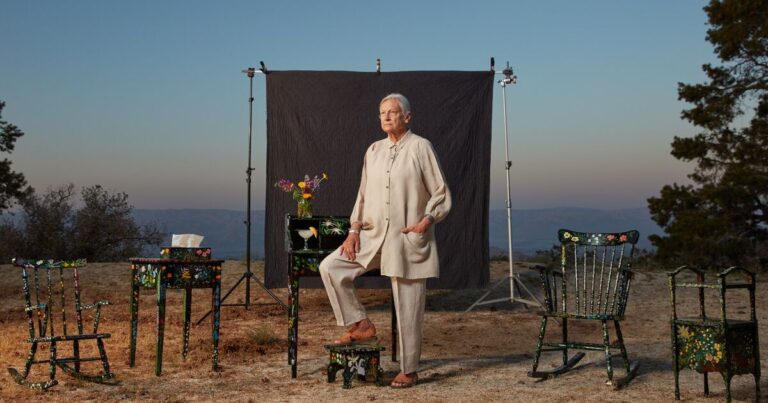Art
Tara Dalbow
Portrait of Jessie Homer French by Ryan Schude. Courtesy of Various Small Fires.
Stealth bombers, wind farms, controlled burns and cemeteries – these are some of the things self-taught artist Jessie Homer French, 83, finds beautiful. She said it bluntly before the opening act of her solo exhibition at Various Small Fires in Los Angeles, and is surprised to learn that not everyone would describe them that way. “Surely other people find stealth bombers beautiful, and shoot? Fire is absolutely beautiful.” Coming from someone else, the sentiment might register as fake or intentionally polemical, but looking at Homer French’s intricate painting of flowers blooming among burnt pine trees, or another of a pearly airplane soaring over a field of turbines, the viewer understands his sincerity. . You see what she sees: a world alternately devastated and renewed by man’s capacity for devastation and rebirth.
Homer French’s gift for seeing what others miss began when she was young. Raised in the Adirondacks in the 1940s, she spent most of her childhood playing in the woods by herself. Driven by a fascination with what she couldn’t see below the stream next to her house, she caught her first fish with her bare hands at the age of three. “I used to have these magical dreams about fish and life under water,” says Homer French. “I’ve always been drawn to hidden things.” Eight decades later, the preoccupation manifests itself in foreboding paintings that offer a revelatory glimpse of the unseen, a sweeping vision of the natural world, and gentle instructions to spot the seedling unfurling from the ashes.
In “Normal Landscapes,” on view through February 17, Homer French’s anti-perspective, false narrative paintings reveal the cyclical nature of life. Remembrance Day (2021), for example, depicts mourners walking among gravestones and shining crosses adorned with flickering candles in a cemetery surrounded by tall conifers. Below them, the subsoil is depicted in cross-section, revealing the men, women and children carefully dressed in repose in their graves. In Down Rush Creek (1994), a river full of glistening trout runs through the remains of a charred forest where scrubby grasses grow beneath the blackened branches. Although fire is absent in that composition, it makes a magnificent appearance across the five-foot width Boreal Burn (2022), where fierce orange, yellow and red flames consume a row of evergreens under an ominous, smoke-stained sky. .
Despite the urgent and striking nature of his paintings, Homer French spent the last 50 years painting in relative obscurity, unnoticed by the art world until recently. “She was the only artist at Art Basel Hong Kong 2019 that no one had heard of,” explained Esther Kim Varet, founder of Various Small Fires, which was largely responsible for introducing Homer French’s work to the public. “The fair committee decided it was the only real discovery in the entire Discovery section.” Since then, his work has spread around the world much like the raging wildfires he paints: he had a solo exhibition at the MASSIMODECARLO gallery in Milan, two of his paintings were reproduced on billboards on the High Line in New York, and he works both in Venice . Biennial in 2022 and the Hammer Museum’s “Made in LA” exhibition in 2023.
“People are looking for sincerity, and since it’s so hard to come by now, when you find it, you want to keep the experience,” Kim Varet said of the artist’s recent rise in popularity. “It’s hard to articulate exactly what it is about his work that makes you love it, but you feel it when you see it. Everyone does.” When pressed to name that, that elusive quality that makes the paintings so compelling, Kim Varet points to a lack of pretense, a straightforward earnestness, and an “existential honesty that resonates with what and who we are now.” Indeed, the two biennials in which the French Homero was included showed a similar tendency towards authenticity.
Given the attention both surveys paid to textiles, it is perhaps surprising that one of Homer’s idyllic French tapestries, known as ‘mapestries’, was not chosen for inclusion in either. Made with fabric, thread, paint and ink, these works feature hand-stitched, colorful topographical diagrams of fault lines alongside familiar landmarks and regional symbols. The Dying Sea (2021), included in the current Various Small Fires program, depicts a crimson line of the San Andreas fault running through a mottled peach expanse dissected by sinuous black interstate lines. Patches of fabric with finely painted palm trees, yucca trees, mountain ranges and tilapia fish populate the facsimile high desert landscape.
The artist herself lives to the west of the area shown, in an isolated, mountainous community surrounded by junipers, sagebrush, coyotes and rabbits, rich in dizzying views. Born and raised in New York, Homer French has lived on the West Coast for the past five decades; first, in Los Angeles, where she met her late husband, talent agent and film producer Robin French; then Vancouver Island, Canada; then western Oregon and La Quinta, California; and now, in the Santa Rosa Mountains above Palm Desert, in a home with panoramic views like the one offered Pinyon Ridge (2023). “Robin always found magical places to live,” she said. “Magic places to paint.”
While walking through the exhibition, Homer French pointed out other paintings of places where he lived and some that he does not have or “not yet”: Ojai, California; Chernobyl, Ukraine; the North Sea. “The place is very important to me, the place and the narrative. Everything is narrative,” he said. Despite their cartoonish forms, flattened colors, and bucolic charm, his paintings transcend simple explanations. They are sincere and mysterious, celebratory and damning, full of hope and desperate sadness, like the experience of to be alive in these uncertain times.

